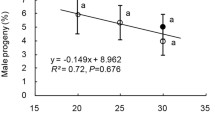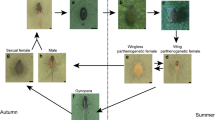Abstract
Wing polymorphisms observed in many Insecta are important topics in developmental biology and ecology; these polymorphisms are a consequence of trade-offs between flight and other abilities. The pea aphid, Acyrthosiphon pisum, possesses 2 types of wing polymorphisms: One is a genetic wing polymorphism occurring in males, and the other is an environmental wing polyphenism seen in viviparous females. Although genetic and environmental cues for the 2 wing polymorphisms have been studied, differences in their developmental regulation have not been elucidated. In particular, there is little knowledge regarding the developmental processes in male wing polymorphism. Therefore, in this study, the development of flight apparatuses and external morphologies was compared among 3 male wing morphs (winged, wingless, and intermediate). These male developmental processes were subsequently compared with those of female wing morphs. Developmental differences between the male and female polymorphisms were identified in flight muscle development and degeneration but not in wing bud development. Furthermore, the nymphal periods of wingless and intermediate males were significantly shorter than that of winged males, indicating the adaptive significance of male winglessness. Overall, this study indicates that the male and female wing polymorphisms are based on different regulatory systems for flight apparatus development, which are probably the result of different adaptations under different selection pressures.







Similar content being viewed by others
References
Blackman RL (1987) Reproduction, cytogenetics and development. In: Minks AK, Harrewijin P (eds) Aphids, their biology, natural enemies and control. Elservier, Amsterdam, pp 163–195
Braendle C, Caillaud MC, Stern DL (2005a) Genetic mapping of aphicarus—a sex-linked locus controlling a wing polymorphism in the pea aphid (Acyrthosipon pisum). Heredity 94:435–442
Braendle C, Friebe I, Caillaud MC, Stern DL (2005b) Genetic variation for an aphid wing polyphenism is genetically linked to a naturally occurring wing polymorphism. Proc R Soc B 272:657–664
Braendle C, Davis GK, Brisson JA, Stern DL (2006) Wing dimorphism in aphids. Heredity 97:192–199
Brisson JA (2010) Aphid wing dimorphisms: linking environmental and genetic control of trait variation. Phil Trans R Soc B 365:605–616
Brisson JA, Davis GK, Stern DL (2007) Common genome-wide patterns of transcript accumulation underlying the wing polyphenism and polymorphism in the pea aphid (Acyrthosiphon pisum). Evol Dev 9:338–346
Caillaud MC, Boutin M, Braendle C, Simon JC (2002) A sex-linked locus controls wing polymorphism in males of the pea aphid, Acyrthosiphon pisum (Harris). Heredity 89:346–352
Dixon AFG (1998) Aphid ecology. Chapman & Hall, London
Dudley R (2002) The biomechanics of insect flight: form, function, evolution. Princeton University Press, Princeton
Harrison RG (1980) Dispersal polymorphisms in insects. Annu Rev Ecol Syst 11:95–118
Ishikawa A, Miura T (2007) Morphological difference between wing morphs of two Macrosiphini aphid species, Acyrthosipon pisum and Megoura crassicauda (Hemiptera, Aphididae). Sociobiology 50:881–893
Ishikawa A, Miura T (2009) Differential regulations of wing and ovarian development and heterochronic changes of embryogenesis between morphs in wing polyphenism of vetch aphid. Evol Dev 11:680–688
Ishikawa A, Hongo S, Miura T (2008) Morphological and histological examination of polyphenic wing formation in the pea aphid Acyrthosiphon pisum (Heteroptera, Hexapoda). Zoomorphology 127:121–133
Ishikawa A, Ogawa K, Gotoh H, Walsh TK, Tagu D, Brisson JA, Rispe C, Jaubert-Possamai S, Kanbe T, Tsubota T, Shiotsuki T, Miura T (2012) Juvenile hormone titre and related gene expression during the change of reproductive modes in the pea aphid. Insect Mol Biol 21:49–60
Kring JB (1977) Structure of the eyes of the pea aphid, Acyrthosiphon pisum. Ann Entomol Soc Am 70:855–860
Lamb RJ, Pointing PJ (1972) Sexual morph determination in the aphid, Acyrthosiphon pisum. J Insect Physiol 18:2029–2042
Lees AD (1966) The control of polymorphism in aphids. Adv Insect Physiol 3:207–277
Marcovitch S (1923) Plant lice and light exposure. Science 58:537–538
Miyazaki M (1987) Forms and Morphs of aphids. In: Minks AK, Harrewijin P (eds) Aphids, their biology, natural enemies, and control. Elservier, Amsterdam, pp 27–50
Orlando E (1974) Sex determination in Megoura viciae Buckton (Homoptera Aphididae). Monit Zool Ital 8:61–70
Roff DA (1990) The evolution of flightlessness in insects. Ecol Monogr 60:389–421
Roff DA, Fairbairn DJ (1991) Wing Dimorphisms and the evolution of migratory polymorphisms among the Insecta. Am Zool 31:243–251
Sack C, Stern DL (2007) Sex and Death in the male pea aphid, Acyrtosiphon pisum: the life-history effects of a wing dimorphism. J Insect Sci 7:1–9
Smith MAH, MacKay PA (1989) Genetic variation in male alary dimorphism in populations of pea aphid, Acyrthosiphon pisum. Entomol Exp Appl 51:125–132
Tsuji H, Kawada K (1987) Development and degeneration of wing buds and indirect flight muscle in the pea aphid (Acyrthosiphon pisum (Harris)). Jpn J Appl Ent Zool 31:247–252
Wagner DL, Liebherr JK (1992) Flightlessness in insects. Trends Ecol Evol 7:216–220
West-Eberhard MJ (2003) Developmental plasticity and evolution. Oxford University Press, Oxford
Wilkinson TL, Ishikawa H (2000) Injection of essential amino acids substitutes for bacterial supply in aposymbiotic pea aphids (Acyrthosiphon pisum). Entomol Exp Appl 94:85–91
Zera AJ, Denno RF (1997) Physiology and ecology of dispersal polymorphism in insects. Annu Rev Entomol 42:207–230
Author information
Authors and Affiliations
Corresponding author
Additional information
Communicated by T. Bartolomaeus.
Electronic supplementary material
Below is the link to the electronic supplementary material.
Rights and permissions
About this article
Cite this article
Ogawa, K., Ishikawa, A., Kanbe, T. et al. Male-specific flight apparatus development in Acyrthosiphon pisum (Aphididae, Hemiptera, Insecta): comparison with female wing polyphenism. Zoomorphology 131, 197–207 (2012). https://doi.org/10.1007/s00435-012-0154-3
Received:
Revised:
Accepted:
Published:
Issue Date:
DOI: https://doi.org/10.1007/s00435-012-0154-3




